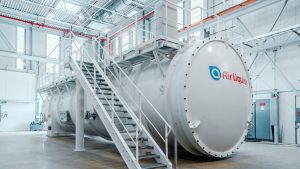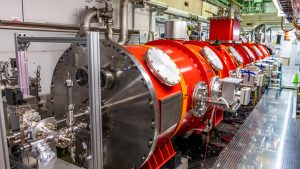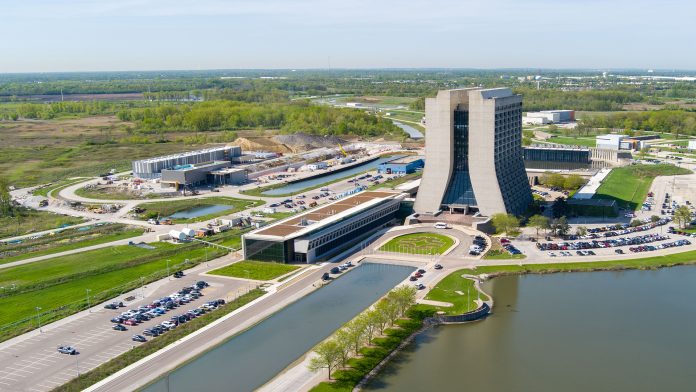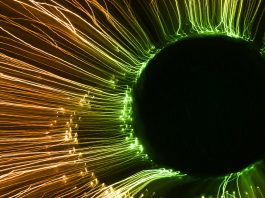Cristian Boffo, Project Director of Fermilab’s PIP-II project, discusses the progress made so far in the major upgrade to Fermilab’s accelerator complex and what this means for future discovery.
Set to power decades of new discovery, the Proton Improvement Plan II (PIP-II) is an essential upgrade to the Fermi National Accelerator Laboratory (Fermilab) accelerator complex in Illinois, US. PIP-II will power the world’s most intense high-energy neutrino beam on its journey from Illinois to the far detector of the Deep Underground Neutrino Experiment (DUNE) in South Dakota – a distance of 1,300km (800 miles). In addition, the upgrades to the existing accelerator complex will enable a broad physics research programme, opening up a vast range of experimental possibilities that have not been in reach previously.
Since construction started in 2022, the project has already secured a number of key achievements. It is currently poised to start assembling a pre-production SSR2 (single-spoke resonator 2) cryomodule at Fermilab. At the same time, collaborators in the UK and France will be assembling two other types of cryomodules: the HB650 and LB650. The new linear accelerator will use five different types of cryomodule and will be made up of a total of 23 cryomodules that will power the beam.
To learn more about the project, its achievements so far, and the next steps, Editor Georgie Purcell spoke to PIP-II Project Director Cristian Boffo.
Can you please tell us more about the background of PIP-II?
PIP-II is a substantial upgrade of the accelerating complex at Fermilab. People typically refer to PIP-II as the new linear accelerator (Linac) that will be used instead of the existing one, which was built in the 1960s. In reality, it is much more than that because part of the project is also the upgrade of the existing accelerator complex – made up of the Booster, Main Injector, and Recycler. We are building a new linear accelerator employing a new technology, superconducting radio-frequency (SRF) cavities, and we are also upgrading the full system.
The main goal of PIP-II is to have a better injection system which can generate proton beams greater than 1 megawatt. A crucial component in the Deep Underground Neutrino Experiment, PIP-II will power a beam that will enable the shooting of neutrinos from Fermilab in Illinois to the Long-Baseline Neutrino Facility (LBNF) currently being built at the Sanford Underground Research Facility in South Dakota. DUNE is the largest project in the U.S. Department of Energy Office of Science’s High Energy Physics programme and aims to unlock the mysteries of neutrinos.
In summary, Fermilab needs PIP-II because it enables the neutrino physics that we are aiming towards. Additionally, upgrading the accelerator system will enable future experiments that are not possible at present.
What have been the main achievements in the project so far?
PIP-II received full funding for the project in 2022 and, since then, we have been in the construction phase of the system. PIP-II actually began many years prior, with an initial concept known as ‘Proton Driver’ that was devised in 2005. This was a much bigger project and evolved with several different names until ‘PIP-II’ was chosen.
PIP-II is funded by an investment of roughly $1bn from the U.S. Department of Energy (DOE), with an additional $300m contribution from international partners. It is the first US-led particle physics project with substantial international contributions, from countries including Italy, France, UK, India, and Poland. As well as financially, the project also benefits greatly from the shared knowledge of our international partners, particularly in critical areas like SRF. If there is a problem, our overseas partners are very well placed to assist us. International collaboration is extremely important for the project. For example, we are currently building three pre-production cryomodules – one at Fermilab, one in the UK, and one in France – with similar tools and facilities. We talk to each other and exchange knowledge to ensure that our thoughts and processes are aligned. If we experience a hiccup, we check what the other team is doing to establish why they haven’t had the same issue.
Civil construction is ongoing. So far, the tunnel is fully excavated and our cryoplant building is complete. The ownership of this has already been given to Fermilab and the building has been filled with the cold box and the warm compressors which constitute the cryoplant. This equipment will cool down the superconducting Linac to 2 Kelvin. Those components are a very large contribution from the Indian Department of Atomic Energy and discussion on this started in 2012. Many people did work on this collaboration, and we are very proud to have received the equipment in December last year. This is being installed in collaboration with the Indian colleagues, and the commissioning phase will begin early next year.
A lot of ongoing work is happening with the SRF cavities. Before receiving the approval for the full budget, we were able to demonstrate in the PIP-II Injector Test (PIP2IT) facility the upper functionality of the front end of PIP-II – meaning that, from the gallium nitride (GaN) transistor to the first two SRF cryomodules, we were able to accelerate beam to the LBNF parameters there. That was a huge risk mitigation for the project that helped with convincing the DOE to release the budget for the full project, because we showed we will meet our goal, at least until the first two cryomodules. Following this, we need another 21 cryomodules of four different flavors, but this is a good start. We currently have contracts with industry for all the flavors of SRF cavities. As I mentioned, we are also completing the pre-production cryomodule this year so that we can next year launch the production of all the flavors of cryomodules for PIP-II in France, the UK, India and at Fermilab.

© Ryan Postel, Fermilab
There is also all the ongoing work on the upgrades. For example, we have delivered a collimator to our accelerator division to enhance the performance of the current accelerator system. PIP-II is already helping to improve the present accelerating chain by delivering hardware to help improve the machines.
Can you explain more about the cryomodules and the pre-production phase?
Superconducting Linacs like XFEL in Europe or LCLS-II at SLAC are electron machines and only use one type of cryomodule. PIP-II will accelerate H- ions which are much heavier than electrons, thus requiring the use of different types of cryomodules and cavities. PIP-II is complex because we have to deal with five types of cryomodule, all newly developed by the Fermilab team and our international partners.
The first prototype cryomodule, known as single-spoke resonator 1 (SSR1), was tested at Fermilab after many years of production and is now machine-ready. We will use the prototype as the first unit in the full machine, which is a huge achievement.
The second cryomodule, the prototype High Beta 650 cryomodule, was built at Fermilab and then shipped via cargo plane to Luxembourg. From here, it went on a truck down the channel to our UK partners close to Manchester. When it was returned to the US and tested here, the same performance was achieved, thus demonstrating that cryomodules can be transported above the Atlantic Ocean without degradation. This was another mammoth achievement.
There are five flavors of RF cavities. All of them, in different ways, push the boundaries of SRF technology beyond the state of the art.
We are also pursuing plasma cleaning on cavities, which allows us to fix cavities that have a problem during the cryomodule installation process or in operation. Previously, if a problem arose, a cryomodule would have to be removed from the machine and fully dismounted to reach the cavities to fix them. Now, we are working on a way to repair them in situ, rather than having to disassemble everything.
What will success at this stage mean for the project in the long term?
Right now, success will be staying on schedule and within budget.
Every day, around 400 people at Fermilab are involved in the project in some way and at least 200 are involved abroad through our international partners. It’s a huge ongoing effort, which is why staying on schedule and in budget is critical.

We are in a very dynamic situation with a lot of changes in the world and market. We are actively going to market to purchase from around the world and this can be a challenge. Our partners are also facing the same challenges and are fully committed to supporting PIP-II and delivering on the promises they made years ago. The co-ordination of this is critical. The goal is to deliver what we said we will do – the build of the 800 MeV Linac and upgrades to the full complex – so that we can later deliver the experiments that the scientists want to pursue.
What’s next for the project following this pre-production cryomodule phase?
The goal point is full production, not just at Fermilab, but also of some of the cavities in Italy, of the low-beta cryomodules in France, the high-beta cryomodules in the UK, and the solid state amplifiers used to power the cavities in India. This is a very critical phase of the project and is due to start next year. The first critical phase is demonstrating that these three pre-production cryomodules meet the performance requirements for the project. If this is successful, we can start full production. At this critical step, we must maintain performance, ensure that the processes are steady in all five countries, and work together to keep the quality needed to be able to achieve optimum performance in these critical components. If this doesn’t happen, we will have to pause production to understand and resolve the issue before we can progress.
Another important milestone planned for next year is that we will place the contract for the Booster connection. This is the connection between the new Linac tunnel to the Booster tunnel. This will involve the removal of structures and equipment, so, for safety reasons, operations must halt at this stage. This critical phase of the project must be carried out in close co-ordination with the rest of the lab in order to minimise disruption.
About Cristian Boffo
Currently, Cristian is the Project Director of PIP-II. Cristian is a mechanical engineer and started his career at Fermilab in the late 1990s. He moved to industry in Germany for 12 years, gaining experience as a project manager whilst still working in the same field on superconducting magnets and accelerating cavities. In 2019, Cristian returned to Fermilab to join the PIP-II project.
Please note, this article will also appear in the 22nd edition of our quarterly publication.





